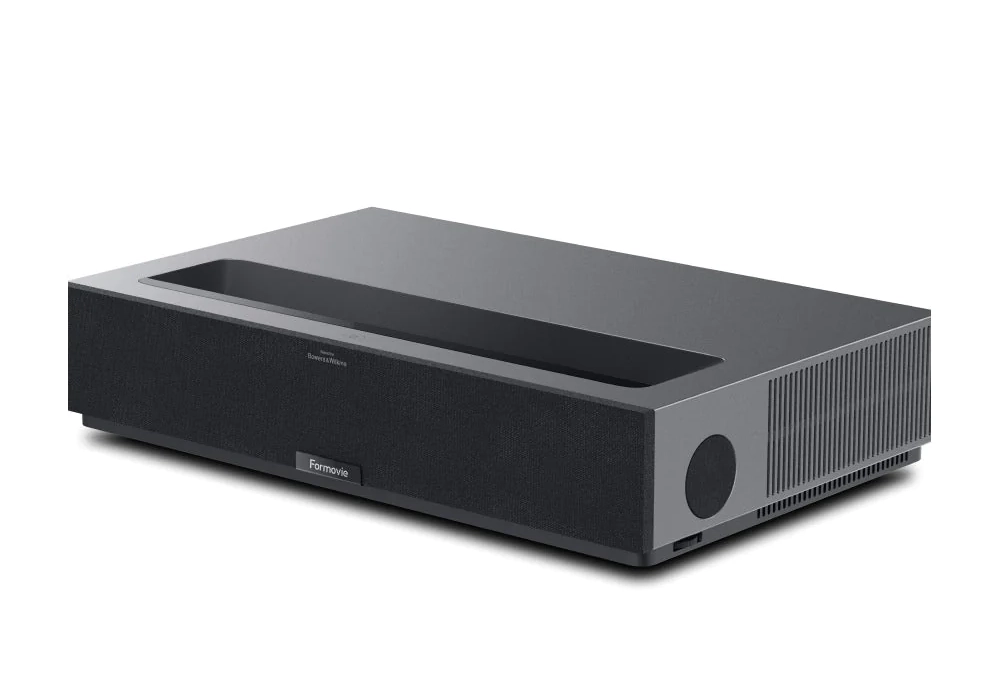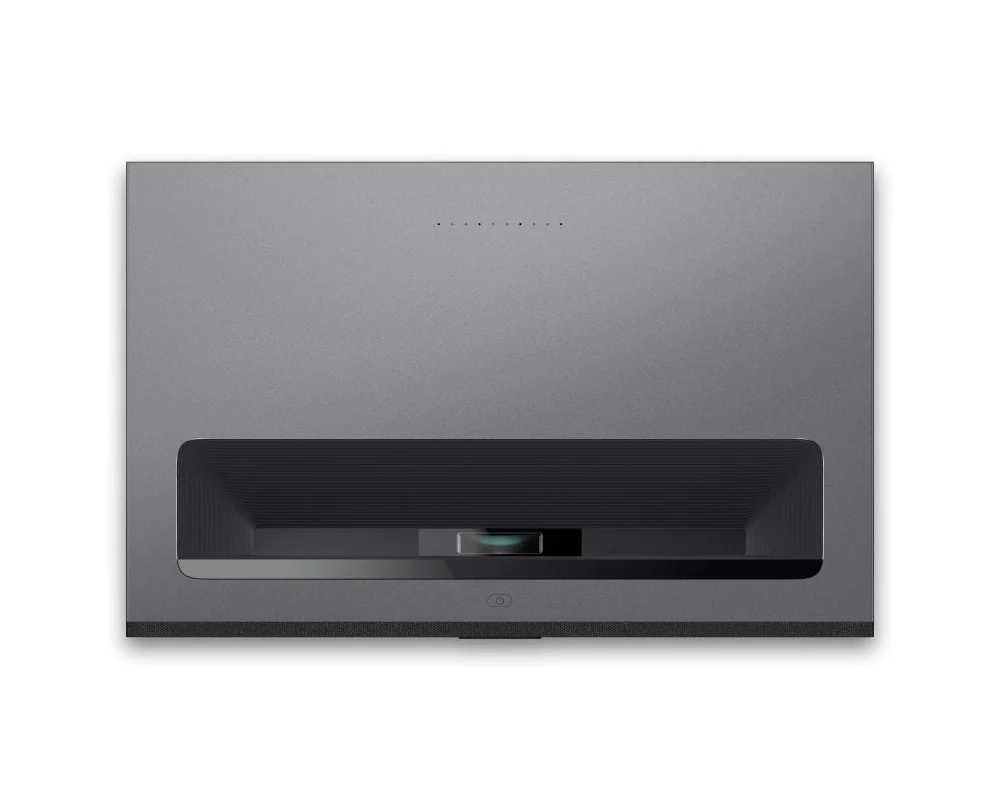Quick Specs
Our Verdict
ProsRemarkable contrast.Compatibility with HDR and Dolby Vision.Comprehensive Android TV.Effective built-in speakers.Quiet operation.ConsInaccurate colour reproduction (especially in HDR).Lack of automatic keyst
Pros
- Remarkable contrast.
- Compatibility with HDR and Dolby Vision.
- Comprehensive Android TV.
- Effective built-in speakers.
- Quiet operation.
Cons
- Inaccurate colour reproduction (especially in HDR).
- Lack of automatic keystone adjustment.
- Limited brightness.
- Absence of Netflix.
- Non-backlit remote control.
- High power consumption.
The Formovie Theatre is a UHD 4K ultra-short throw projector that boasts strong contrast, along with HDR and Dolby Vision compatibility. Additionally, it includes a Bowers & Wilkins audio system.
Overview
Chinese manufacturers are gaining momentum in the projector market. Formovie seems to have made a significant impact with its Theatre model, receiving outstanding international reviews. This ultra-short throw model boasts 4K UHD definition through wobulation, image sizes up to 150 inches, Android TV 11 OS, and promising features like 2800 ANSI lumens brightness, 3000:1 contrast, and rare Dolby Vision compatibility on the market. Powered by a tri-laser ALDP 4.0 source, its lifespan is claimed to be 20,000 hours, far exceeding a standard UHP bulb, equating to 13 years of use at 4 hours per day. A notable bonus is the 30W Bowers & Wilkins audio system. We were eager to test it and see if this projector deserves its crown as the current best ultra-short throw model. The Formovie Theatre is priced at €3200, slightly more expensive than its direct competitors (Dangbei, Hisense, Xgimi), but much less than Samsung's Premiere or Sony's VPL-XW5000, for example. Currently, it's available for around €2800 on promotion, with potential for further price drops.

2D Image Quality
Upon powering up, the projector focuses automatically but lacks automatic keystone correction. Hence, proper positioning relative to the wall or screen is essential to avoid manual adjustment via the interface. If the projector is stored after each use, precise placement is necessary. The focus is generally good, but the upper corners are not entirely sharp. This can be improved through a dedicated menu, greatly enhancing the outcome. Ideally, place the projector 14 cm from the screen for an 80-inch image, 33 cm for 120 inches, and 49 cm for 150 inches.
Thanks to tri-laser technology, the "rainbow effect" perceived by some users is less pronounced than with single-laser projectors, but it doesn't completely disappear. Some are sensitive to it, seeing coloured dots around bright objects on dark backgrounds, while others are not. The Formovie Theatre offers extensive colour setting adjustments (colour temperature, hue, saturation, luminance, etc.), great for those willing to fine-tune for improved calibration. However, out-of-the-box results are not very good… It's also possible to adjust the Theatre's light power in the Projector menu: office mode for the brightest, viewing for versatile use, and night to reduce brightness.
By selecting the Film mode in SDR and activating Colour Space in the advanced settings, we managed to reduce the delta E to 5.7, decent for a projector but above the threshold of 3, beyond which colour deviations are noticeable. Other adjustment modes include Sport, Games, Vivid Colours, and Kids, but they aren't very descriptive for altering colour rendering. Some projectors now manage to stay under a delta E of 3 straight out of the box, but it's still rare.
The average colour temperature of 7150 K is slightly cool but doesn't stray too far from the 6500 K reference. Similarly, the average gamma is fairly stable at 2.1, and grey levels are well reproduced on screen, though the ideal target is an average of 2.2.
Regarding contrast, the result is impressive for an ultra-short throw projector. We measured a contrast of 2170:1 in Film mode, and even slightly over 3000:1 in standard mode.
Formovie claimed 107% coverage of the Rec 2020 colour space, but the actual result is less rosy. Nonetheless, we measured 81.7% coverage, one of the best results in our comparison. The DCI-P3 space, most used in cinema, is covered at 99.4%. Excellent indeed. HDR The Formovie Theatre supports HDR, HDR 10+, and is one of the few models on the market to handle Dolby Vision. In the Visualisation brightness mode and Standard mode, brightness can reach 150 cd/m², but we recorded 80 cd/m² in Film mode, which is somewhat disappointing. For comparison, many projectors are around 100 cd/m², with the best in our comparison reaching 200 cd/m². In any case, the Formovie Theatre is best used in darkness to fully enjoy the dynamic range and contrast.
However, HDR colour reproduction is catastrophic. Even in Film mode, we measured a delta E of 21, far too high. We managed to lower it to a delta E of 13 using calibration profiles found online, and it's likely possible to improve further by calibrating the projector according to room conditions (screen, wall, ambient light). The result might be better on other Theatre series models, but our test model was disappointing.

Input Lag
The Theatre's input lag is quite low, capping at about 43 ms in game mode. Thus, there's a display delay of just over two images between activating a controller and its effect on screen. This isn't a big deal in single-player games, but could matter in competitive multiplayer. Note that in standard mode, input lag is much higher (109 ms). The ALLM (Auto Low Latency Mode) technology is also present; home consoles will be automatically detected, and the projector will switch to game mode to reduce input lag.
Functions and Ergonomics
The Formovie Theatre is a large projector, weighing 9.8 kg and measuring 55 cm in length, 35 cm in depth, and 11 cm in height. Installation is straightforward, aside from plugging in its power cable.
The feet are height-adjustable using two dials on the sides. A sensor near the lens cuts the laser if someone passes in front of it, effectively protecting eyes, but it's not always responsive. This detection was less reactive than on the Xiaomi 4K Laser, for example. It's also possible to mount the projector on a stand or even on the ceiling, but the simplest method is placing it on the floor or a piece of furniture.
The remote control is quite basic, as is often the case with Android TV. It features a wheel for navigating menus, volume buttons, and shortcuts to focus and keystone settings, general settings, YouTube, and the home screen. A microphone is included for Google voice commands, but the remote isn't backlit, which quickly becomes inconvenient in a dark room during movie viewing. The Android TV 11 operating system is relatively smooth and includes several streaming apps like Amazon Prime Video, Arte, Disney+. Unfortunately, Netflix is consistently absent with projectors. The best option is to use a third-party media box like Amazon's Fire Stick, Nvidia Shield, or Apple TV for access to all standard services and improved fluidity. The connectivity options are fairly comprehensive with three HDMI 2.1 ports, one of which supports eARC, two USB-A 2.0 ports, a mini-jack output, an optical SPDIF input, and an Ethernet port. The built-in speakers offer surprisingly good sound for a projector. The bass is present (though limited by the physical capabilities of the casing) and the rest of the spectrum is well reproduced. However, it's best not to turn the volume up too high, as distortion becomes unpleasant beyond about 50%. The stereo space is also limited and doesn't extend much beyond the projector itself. A dedicated soundbar is recommended for a more immersive experience.

Power Consumption and Noise
Level The operating silence of the Formovie is noteworthy: we recorded just 31.2 dB at 1 m. The faoise is very slight and will be covered by the sound of your films anyway. On our test pattern, the projector consumes 280 W in Film mode, which is energy-intensive! The latest models we tested are around 150 W, but technologies and systems greatly vary power consumption, of course.
Conclusion
The Formovie Theatre is an excellent ultra-short throw projector in many respects: the quality of the rendering, its high contrast, good HDR compatibility, and an effective Bowers & Wilkins audio system. Unfortunately, out-of-the-box colourimetry is disappointing, particularly in HDR where the delta E is very high. Calibration is necessary for a viewing experience closer to the original works.
Ready to Purchase?
Check current prices and availability on Amazon
Affiliate Disclosure: Truthful Reviews is a participant in the Amazon Services LLC Associates Program and Amazon EU Associates Programme, affiliate advertising programs designed to provide a means for sites to earn advertising fees by advertising and linking to Amazon.com and Amazon.co.uk. This means if you click on an Amazon link and make a purchase, we may receive a small commission at no extra cost to you. This helps support our independent testing and honest reviews. Our editorial content is never influenced by advertisers or affiliate partnerships.

